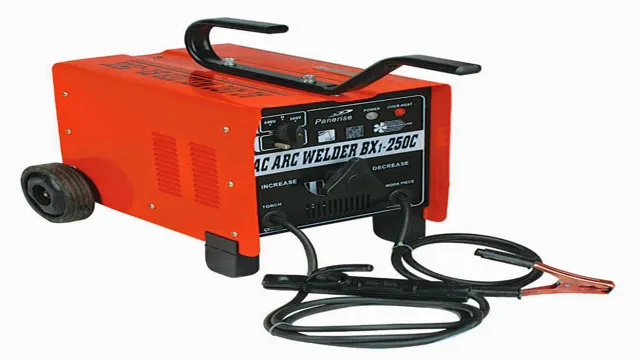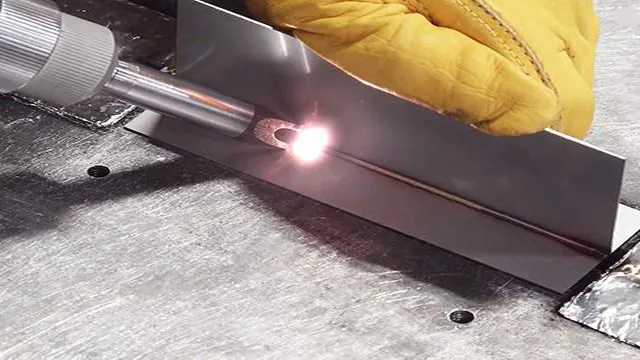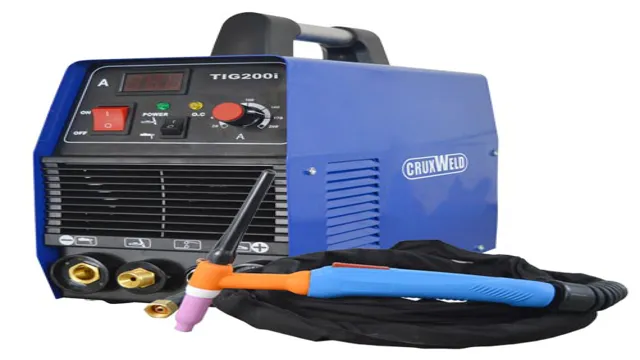What is the Duty Cycle of a Welding Machine? Understanding Optimal Usage for Efficient Work

Do you know what the duty cycle of a welding machine is and what it means for your welding projects? Essentially, the duty cycle of a welding machine refers to the amount of time a machine can be used within a specific period before it needs to cool down. Understanding this concept is crucial, especially when working on long welding projects or when working with high amperage settings. Think of it like a marathon runner who needs to take breaks and rest before continuing to run.
Similarly, a welding machine needs to take breaks and cool down before continuing to perform at its optimal level. By understanding the duty cycle of your welding machine, you can avoid equipment damage, as well as produce consistent and high-quality welds. In this blog, we will dive deeper into the duty cycle of welding machines and provide tips on how to use this knowledge to your advantage.
Whether you’re a beginner or an experienced welder, understanding the duty cycle of your welding machine will ultimately save you time, money, and frustration.
What is Duty Cycle?
If you’re new to welding, you may have heard the term “duty cycle” thrown around and wondered what it means. Simply put, duty cycle refers to the amount of time a welding machine can operate at its maximum output in a 10-minute period. For example, a welding machine with a duty cycle of 60% can weld at its maximum output for six minutes out of every 10, before needing to cool down for the remaining four minutes.
The duty cycle is an important factor to consider when choosing a welding machine, as it determines how long you can weld continuously without having to stop and wait for the machine to cool down. Overall, understanding the duty cycle of a welding machine can help you make informed decisions and ensure that your machine is operating at its best.
Definition and Explanation
Duty Cycle is an essential term used in the realm of electronics and machinery. It refers to the percentage of total time that a device or machinery can operate effectively without overheating or damaging its components. In simpler terms, it is a measure of how long a machine can run before requiring a rest period to prevent overheating or failures.
For instance, if a device is rated with a 50% duty cycle, it means that it can run for 30 minutes without stopping but must rest for the next 30 minutes before continuing its operation. Duty Cycle is a crucial factor in various devices such as generators, welding machines, and motors. By understanding the duty cycle of a device, you can operate it safely, avoid accidents, and prevent damage to the equipment.
Therefore, it is crucial to know the rated duty cycle of your machine and its corresponding resting period to ensure it operates correctly and meets its promised lifespan.

Importance of Duty Cycle in Welding Machines
Duty Cycle Welding machines are an essential tool for welders. Duty cycle is a term that is used commonly with welding machines but is often misunderstood. Simply put, Duty cycle refers to the amount of time a welding machine can operate at maximum output within a 10-minute period.
For example, a welder with a 50% duty cycle can work for 5 minutes at a maximum output and rests for the next five minutes. It is important to take into account the duty cycle to avoid overheating the machine. Welding machines with high-duty cycles allow welders to work for extended periods, increasing productivity and efficiency.
When buying a welding machine, it is essential to understand the duty cycle and buy one that fits your needs. A high duty cycle might make your work more efficient but could come at a higher price point. It’s essential to balance your budget, workload, and the welding machine’s capability when making a purchasing decision.
How is Duty Cycle Measured?
When it comes to a welding machine, duty cycle is an essential factor to consider. But what exactly is the duty cycle, and how is it measured? The duty cycle is the amount of time a welder can operate without overheating. It’s measured as a percentage and refers to how long the machine can weld in a 10-minute period.
For example, if a welding machine has a 60% duty cycle, it means that it can weld for six out of the ten minutes without overheating. Moreover, it’s essential to understand that the duty cycle varies depending on the machine’s amperage output. The higher the output, the lower the duty cycle.
It’s crucial to stick to the recommended duty cycle to prolong the life of the machine and ensure efficiency. Therefore, it’s important to check your welding machine’s duty cycle before using it for extended periods. By doing so, you’ll guarantee that your welding machine can handle the task at hand without overheating or shutting down, resulting in a more efficient and effective welding process.
Measuring Duty Cycle and Ratings
Duty Cycle Duty cycle is a critical rating for many electrical and mechanical devices. It refers to the percentage of time that a device can operate before needing to take a break or cool down. Duty cycle is crucial to ensure that a device doesn’t overheat or become damaged due to excessive use.
To measure duty cycle, engineers track the amount of time a device operates and compare it to the time it takes for the device to cool down. Duty cycle is typically expressed as a percentage and is a crucial factor in determining the longevity of a device. Without proper consideration of a device’s duty cycle, it could easily fail or require frequent maintenance, which can be costly in the long run.
Accurately measuring duty cycle is essential for ensuring that devices operate efficiently and meet the demands of their intended applications.
Factors Affecting Duty Cycle of Welding Machines
Duty Cycle of Welding Machines When it comes to welding machines, the duty cycle is a crucial factor that determines how efficient and reliable the machine is. To put it simply, the duty cycle is the amount of time a welder can operate before it needs to cool down to prevent overheating. Duty cycle is measured as a percentage of a 10-minute cycle, with the amount of time the welder is running compared to the amount of time it needs to rest.
For instance, if a machine has a 60% duty cycle, it can run for 6 minutes straight before requiring a 4-minute break. Duty cycle is determined by factors like the welding machine’s design, its components, and the environment it’s used in. Welders should choose a machine with a duty cycle that meets their needs to ensure they can complete their tasks efficiently and without pauses.
Understanding how duty cycle is measured is vital for anyone looking to invest in a welding machine.
Interpreting Duty Cycle Ratings
Duty cycle ratings are commonly used to determine how long a device can operate before needing a break. This rating is usually expressed as a percentage, and it reflects the amount of time a device can operate in a given time period. For example, if a device has a 50% duty cycle rating, it means that it can operate for half the time and then needs to rest for the other half.
Duty cycle ratings are measured based on the device’s overall performance and lifespan. Devices with higher duty cycle ratings typically have longer lifespans and can operate for extended periods without overheating or malfunctioning. It’s important to consider a device’s duty cycle rating when choosing the right tool for your application, as it can impact productivity and efficiency.
Overall, duty cycle ratings are a helpful tool in determining the operational capabilities of a device and ensuring optimal performance.
Choosing the Right Welding Machine Duty Cycle
If you’re in the market for a welding machine, understanding the duty cycle of the machine is crucial. The duty cycle refers to the amount of time a welder can operate before needing to cool down. A machine with a 60% duty cycle can operate for 6 minutes before needing a 4-minute cooldown period.
A higher duty cycle means a longer operating time, but keep in mind that the higher the duty cycle, the more expensive the machine will be. It’s important to consider the amount and type of welding you plan to do before investing in a welding machine. For heavy-duty applications, a machine with a high duty cycle is necessary to prevent overheating and performance issues.
However, for occasional DIY projects, a lower duty cycle machine may suffice. Understanding the duty cycle can help you make an informed decision and choose the right welding machine for your needs.
Matching Duty Cycle to Welding Needs
Welding machines come with different duty cycles, and it’s crucial to choose the right one for your welding needs. The duty cycle refers to the amount of time a welding machine can operate continuously without overheating. It’s represented as a percentage, such as 60% or 80%, and indicates the ratio of welding time to rest time.
For instance, if a welding machine has a duty cycle of 60% at 200 amps, it means it can weld for 6 minutes continuously, and then it needs to rest for 4 minutes. If you exceed the duty cycle, the machine may overheat, and you risk damaging it or reducing its lifespan. Therefore, consider the type of welding tasks you’ll be handling and the frequency of use before selecting a welding machine with an appropriate duty cycle that can handle the job without interruptions.
Calculating Required Duty Cycle for Specific Projects
When it comes to welding, calculating the required duty cycle is crucial in ensuring the success of your project. Duty cycle represents the amount of time that a welding machine can operate at its maximum amperage without overheating. Before selecting a welding machine, it’s important to determine the required duty cycle based on the specific needs of your project.
Factors such as the material being welded, thickness, joint type, and welding position can all affect the required duty cycle. By choosing the right duty cycle for your project, you can avoid the risk of equipment failure or damage and achieve high-quality welds with ease. So, take the time to do your research and determine the required duty cycle for your project before starting any welding job.
Maintaining and Maximizing Duty Cycle
When it comes to welding machines, understanding the duty cycle is crucial to maintaining and maximizing their efficiency. The duty cycle refers to the amount of time that a welding machine can operate without overheating or malfunctioning. This cycle is typically represented as a percentage, such as 60%, which means that the welder can operate for 6 minutes out of every 10 before requiring a rest to cool down.
To maintain and maximize the duty cycle, it is important to ensure that the machine is not overloaded beyond its capacity. This means choosing the right size and type of welder for the job and not exceeding its amperage rating. It is also essential to perform regular maintenance such as cleaning the machine and replacing consumable parts like filters and contact tips.
By following these tips, welders can ensure their machine operates at its maximum capacity and can deliver the best possible results for their welding projects.
Tips for Maximizing Duty Cycle Efficiency
Duty Cycle Efficiency When it comes to maximizing duty cycle efficiency, there are a few tips to keep in mind. First, proper maintenance is key. Regular cleaning and oiling of your equipment can ensure it runs smoothly and may even extend its lifespan.
Additionally, monitoring your usage patterns can help you determine when and how frequently to use your equipment, avoiding overuse and reducing wear and tear. Another important factor is timing – knowing the appropriate downtime and cooldown periods for your equipment can make a big difference in efficiency. And lastly, consider your power source.
Making sure you have a reliable power supply and using energy-efficient equipment can help you maximize your duty cycle and save on energy costs. By following these tips, you can maintain and optimize your duty cycle for peak efficiency and productivity.
Maintaining and Monitoring Welding Machine Duty Cycle
Maintaining welding machine duty cycle is essential for ensuring consistent and timely production of high-quality welds. Duty cycle refers to the length of time a welding machine can operate at its maximum output without overheating or malfunctioning. It is dependent on factors such as the machine’s power capacity, cooling system, and ambient temperature.
To maximize duty cycle, it is crucial to operate within the machine’s rated capacity while periodically checking for possible malfunctions that can cause downtime. Regular cleaning and inspection of the cooling system can ensure that the machine operates at optimal temperature, preventing overheating and prolonging its lifespan. It is recommended to keep a log of machine usage and consistently monitor its duty cycle to identify patterns and avoid unforeseen breakdowns.
By maintaining and monitoring welding machine duty cycle, you can ensure continuous production and avoid delays in your welding projects.
Conclusion
So, to sum it up in a clever and witty way, the duty cycle of a welding machine is like a delicate dance between work and rest. Just like a ballerina who needs to alternate between graceful movements and moments of stillness, a welding machine also needs to balance its output and downtime to prevent overheating and ultimately preserve its lifespan. So, the next time you’re welding away, remember to give your machine a break to keep it in tip-top shape!”
FAQs
What is a duty cycle in welding machines?
A duty cycle refers to the amount of time a welding machine can be used before it needs to cool down. It is typically expressed as a percentage, such as 60%, and indicates the percentage of 10 minutes that the welder can be operated before resting for the remaining time.
How do you calculate the duty cycle of a welding machine?
To calculate the duty cycle of a welding machine, you need to know its rated output and the recommended duty cycle for that output. Multiply the rated output by the duty cycle percentage to determine the number of minutes the machine can be used continuously before it needs to take a break.
What happens if you exceed the duty cycle of a welding machine?
If you exceed the duty cycle of a welding machine, it can overheat and cause damage to the internal components. This can lead to reduced performance and even complete failure of the machine. It is important to follow the recommended duty cycle to ensure the longevity and proper function of the welding machine.
Can you increase the duty cycle of a welding machine?
It is not recommended to increase the duty cycle of a welding machine beyond its manufacturer’s specifications. Doing so can cause overheating and damage to the machine. If you require a higher duty cycle, consider purchasing a machine with a higher rating to meet your needs.
What factors affect the duty cycle of a welding machine?
Several factors can affect the duty cycle of a welding machine, including the ambient temperature, the electrode size and type, the amperage setting, and the welding technique used. It is important to consider these factors and adjust the machine’s usage accordingly to prevent exceeding the recommended duty cycle.
Why is duty cycle important in welding?
Duty cycle is important in welding because it helps to prevent damage to the machine and ensure proper performance. Exceeding the recommended duty cycle can cause overheating and damage to internal components, reducing the lifespan of the machine and affecting its function. By following the recommended duty cycle, you can ensure that the machine operates safely and efficiently.
What is the difference between duty cycle and amperage in welding?
Duty cycle and amperage are two separate factors in welding. Duty cycle refers to the amount of time a welding machine can be used continuously before it needs to cool down, while amperage refers to the amount of electrical current used to create the weld. While they are both important considerations in welding, they are not interchangeable and should be considered separately when selecting and operating a welding machine.







